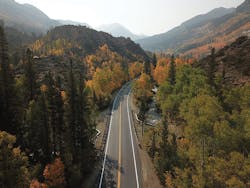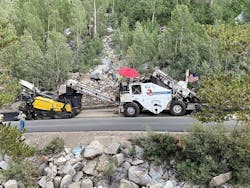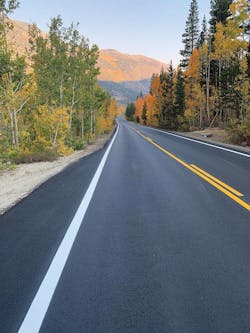Recycling Awards 2021: Hat Trick
Inyo National Forest is located in the southeastern part of California, near the town of Bishop.
Though it is a picturesque landscape of clear waters, jagged mountains, and lush greenery seemingly divorced from the state’s sprawling metropolises, it is, in fact, only a few hours’ drive from the polyglot city of Los Angeles, making it an environment that is at once isolated and accessible. This conflation presented a rather significant challenge to Hat Creek Construction & Materials as it proceeded with the full-depth reclamation and rescue of South Lake Road.
“South Lake is very popular for camping and fishing, particularly fly fishing,” Tony Bolman, project manager for Hat Creek, told Roads & Bridges. “The U.S. Forest Service, which owns the road along with Inyo County, said that during our summer construction window they had over a 100% increase in visitors due to the pandemic. Even though this project site was up in the mountains, it’s only about four hours from Los Angeles, so when everything first got shut down—schools closed, lots of folks remote working—everybody tried to get out of L.A. and came up for some recreation.”
The South Lake Road project consisted of the full-depth reclamation and restoration of just over 8.5 miles of extremely narrow, winding two-lane road at an elevation that ranged from 8,000 ft to 9,800 ft at the project’s farthest limit. The road is a direct feed to South Lake and its environs, which includes a small residential community as well.
“It’s primarily a recreational road for campgrounds and use by the Forest Service,” Bolman said, “but there is also a small residential area in the middle of the project limits, about 20 houses in all, some with year-round residents.”
When crews readied for a late spring 2020 work start, in addition to the extreme elevation and pending vacation season they were challenged by, of all things, a whole lot of snow.
“They get a lot of snow in the winter. The county only typically plows the first 3 miles of what is the project limits and the last several miles is shut down in the winter,” Bolman said. “We had preconstruction set for April before beginning work in May, and the county had the road open, but two days before the precon, a storm came through and dumped 6 ft of snow on the job. So there was snow on the ground when we got there. We couldn’t start until May 11. The upper half of the job still had a lot of snow on the road, and the entire project had snow around the edges the whole way through. Actually, the surveyor struggled to dig down through snow to set the survey stakes.”
SERIOUSLY BIG ROCKS
The project called for the removal and pulverization of approximately 8 in. of material, but it also required the change-out of nearly four dozen culverts, and it was this process, ahead of any milling or paving work, that had crew members occasionally scratching their heads and marveling at the kind of terrain they were facing.
“It was an extreme amount of rock,” Bolman recalled. “We had 45 culverts to change, to replace with larger structures, and since it is a narrow roadway, it was difficult to keep traffic in one lane. Some of the pipes were as deep as 25 ft. You’d be trying to put in an 18-24 in. pipe and you’d be facing 10-ft boulders that you couldn’t get out, which made your trenches a lot bigger than you wanted or needed them to be. We had initially figured that for the pipe work a lot of that dense rock had been addressed when the road was originally built, but we found that wasn’t the case at all. There were a lot of large boulders, including some we couldn’t get out of there. We had to just move them away from the pipe. I remember one that was the size of a vehicle, about 12 ft across. We were allowed to work it to the mountain side and leave it there, but it was a heck of a challenge.
“And before all that, the road was in really bad shape when we began,” Bolman said. “Cracks and heaves and so forth. And since the road is quite narrow, pavement was cracking off and falling away in many places right at the fog line. We actually had to do some dirt work on the first 2 miles, past the residences, in order to widen a bit and give the lanes that stability they were lacking, and also to help accommodate bike traffic, which you get a lot of up there.”
There was a lot of refill work following the installation of the new pipes, and due to this, or perhaps alongside it, the decision by the Federal Highway Administration, which designed this project, to go with FDR turned out to be a terrific benefit.
“There was too much damage just to do, say, a 3-in. mill and fill,” Bolman said. “I don’t know if there was a consistent level of ashpalt on it anyway. If you had to grind it off and then haul in a bunch of rock with the site being so remote, it would have been a big challenge. The site was only 15 or so miles from the rock sources, but it was uphill the whole way to get from there to the site. By doing the FDR, it reduced a lot of imported rock that would be needed.”
PAVING IN A PANDEMIC
When COVID-19 made its initial clampdown on the West Coast, Inyo County was hit particularly hard, a combined result of people at that time not knowing the later-understood details of transmission and the county’s function as a way-station for urbanites.
“One agreement we made with Inyo County and the Forest Service was that workers would not stay in hotels in town,” Bolman said. “They all stayed in RVs. The county had shut down after the first wave of people coming out of Los Angeles. Inyo County got hit pretty hard during that first wave, so they were very strict with us. They shut down most hotels and kept only a couple open just for essential workers. We had to keep our people isolated.”
Fortunately, this was Bolman’s seventh season working on FHWA projects for Hat Creek, and he and his crew were adept at rolling with the punches. The limited right-of-way also meant that there was a dearth of places to install or adapt for turnarounds, which meant that coordination between the hauling and paving crews often became a jumble of necessity—notably as they were fighting the enormous increase in vehicular traffic to the area.
“Luckily at the very end, when we were paving, the Forest Service shut down its campgrounds, so it got a little easier,” Bolman recalled, “but during the pulverizing and pipework, it was an extraordinary amount of traffic to deal with. There are trailheads from the lake that connect to the Pacific Coast Trail, so sometimes people would park a car on the pullout or even on the road itself and be gone two or three weeks before they would come back to get their car. One day we actually had about 16 cars parked right in the middle of the road where we needed to pave. We ended up having to skip that section and come back to it.”
Nonetheless, solutions were able to be fashioned—even if they did, in one instance, bring about another unwanted obstacle: “We paved with belly dumps. One was in the middle of the job. There were only three turnarounds the whole way, and we were facing all that recreational traffic as well, but I was able to close a parking lot at the very top of the project and turn trucks around there. It was so narrow, though, that our paver actually got hit by one of our transport trucks. It ripped off a ski and damaged the screed, so we had to finish up the project with our backup paver.”
Despite this final hiccup, paving ops proceeded smoothly. After the 8 in. of material was pulverized with a Wirtgen WR-240i and the replaced material was graded by a Deere 770G, a prime coat emulsion was put down on the stabilized base and left to settle for two weeks. Then crews buttoned things up with a pair of 1.5-in. FHWA SuperPave 1/2-in. gyratory mix lifts laid down by a BOMAG CR1030T fed by a Roadtec SB 1500 shuttle buggy, so chosen for its ability to work in the confined width of the roadway.
All told, the first 2 miles equaled 11-ft lanes with 3-ft shoulders, and 10-ft lanes with 1-ft shoulders thereafter, resulting in a $10 million win and a road that will see residents and visitors through many years to come.


